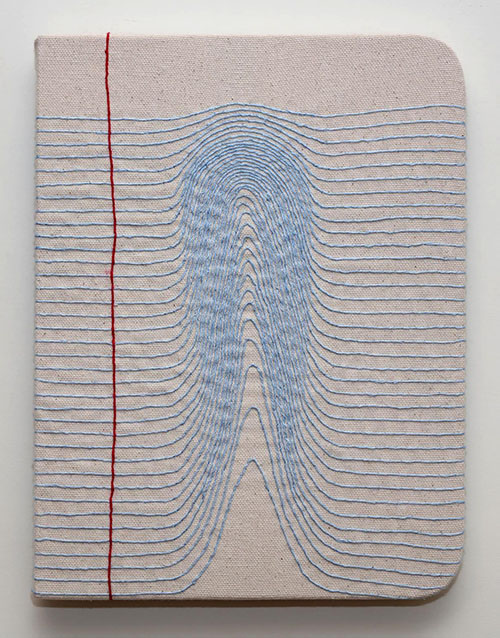Notes for String Theory
Notes for String Theory are hand-embroidered pages that confront the existential possibilities of the blank page. The size, format, and color palette of notebook paper, they are familiar and warped at the same time. From across the room, they appear as flat, linear designs, but upon closer inspection reveal themselves to be delicately textured with individual stitches in thread. My work has taken literature as its subject for many years, and writing has been central to my artistic practice. As Covid-19 changed all our lives, I found it arrested my ability to compose a coherent text. The stories and commentary that had previously poured out of me were now blocked. As the winter storms of early 2021 compounded our isolation, I began drawing versions of a bare sheet of paper in blue thread onto canvas. Where I had previously embroidered the text and illustrations of my artist's books, I created a void. Not the first or last to confront the dread of the blank page or to bend writer's block into subject matter, I have named my humble drawings for the theoretical framework uniting all matter and forces at play in the universe.

This most recent series focuses on the blank pages of the notebook as optical potentialities. Writer's block may have been the inspiration, but there are innumerable possibilities for these linear designs. I draw from art historical references, especially optical art from the 1960s. The works are modular in that they can be hung in many different configurations, allowing narratives to emerge depending on the arrangement. Notes for String Theory was chosen as the title because textile puns are especially groan-worthy. As a branch of physics, string theory allows us to postulate many dimensions, a world-view that has had a huge impact on our collective imagination.

Common Threads
I started using embroidery, initially, as a way to produce textile artist's books that felt and looked like tactile simulations. Common Threads is a long-running series of hand- embroidered unique canvas books which copy the form and design of "composition" books. The books themselves, self-consciously hand-made objects, are a record of coincidental occurrences gleaned from reading or mundane events. The use of embroidery thread allows for the production of the text and image with the same mark and material, to make the text, image, and substance of the book inseparable. All the content comes from my reading. I've collected coincidences for ten years. It started when I read two books in a row that both included the phrase "antique dental instrument." While that was not the first coincidence I ever noticed in my reading, that singular instance convinced me to keep a record. I began to consider that the phrase might have been the profound masquerading as the mundane. Or not. But I wanted to collect the data. I cataloged my coincidences in composition books that filled rapidly. As it turned out, "antique dental instrument" has not held any special meaning in my life or my art. Neither have any of the coincidental phrases that followed, such as "stuffed mountain lion" or "black currant lozenge," but the act of noticing them became the lens through which I filter the world and my experiences.
As an ardent reader, I naturally gravitate toward creating books and printing. And taking note of coincidences is akin to the kind of observation a landscape or portrait artist practices. Thus, my observations take the form of hand-stitched texts that I call Common Threads. Sewing every line, letter, and illustration in the books enhances their status as objects. By laboring over a composition book, painstakingly recreating it by hand, I have found a way to express the insignificant as potentially philosophical. Just as a landscape or portrait painter's observations allow them to reproduce a version of reality, my scrutiny of repetition creates a narrative that navigates fictional universes.


With a background in book art, Candace Hicks's work is based on reading fiction. With the exhibition Read Me at Lawndale Art Center, Hicks opened the book form into a room-sized interactive installation in which viewers pieced together a puzzle of narrative to find the correct solution. The Locked Room at Living Arts in Tulsa focused on a specific genre of literature, the "locked room" mystery, and visitors were tasked with the challenge to find the means of metaphorically escaping the gallery. Egress at Pump Project explored literary connections and coincidences through sculpture and text. Her installation Many Mini Murder Scenes at Women and Their Work immersed visitors in an experience in detection. Secret Passage at Blue Star Contemporary in San Antonio combined a reading room for hand-stitched artist's books and a glimpse into a vast hidden chamber beyond the gallery. She is the Coordinator of Foundations at Stephen F. Austin State University. She earned a Master of Fine Art degree in Printmaking from Texas Christian University. Her artist's books are in collections including the Museum of Modern Art New York, the Metropolitan Museum of Art, Bainbridge Museum, Spencer Museum of Art, and many university special collections including Harvard, Yale, MIT, and Stanford.



